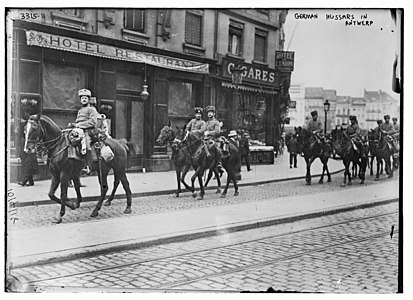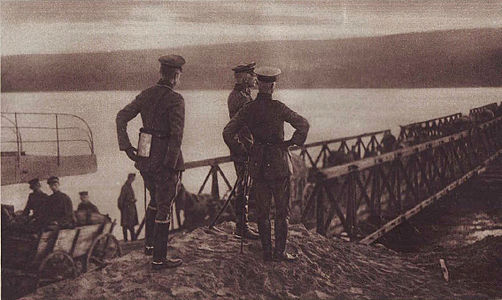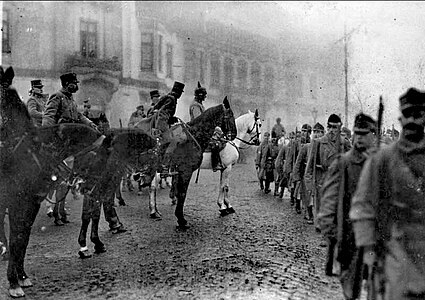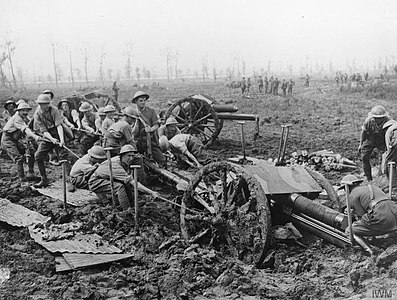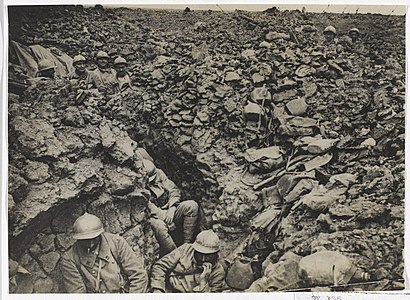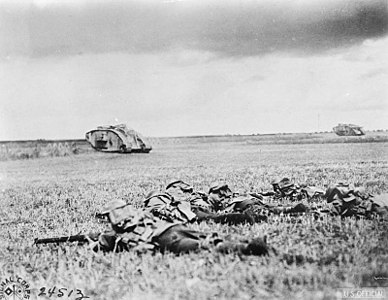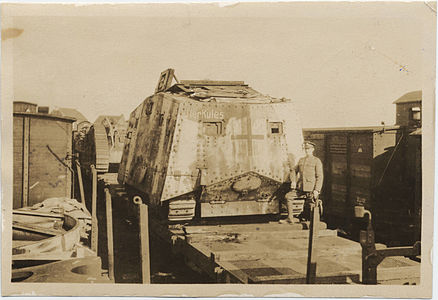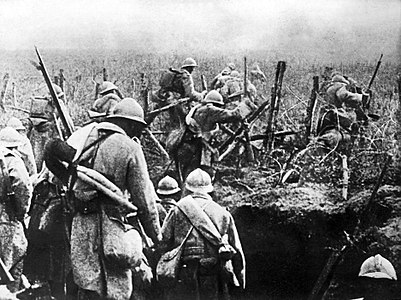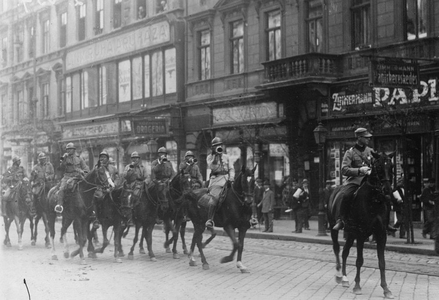Marsh Wars (Pacifica): Difference between revisions
No edit summary Tag: 2017 source edit |
Tag: 2017 source edit |
||
| Line 70: | Line 70: | ||
===Ezervulge — ''Szilágyi''-plan=== | ===Ezervulge — ''Szilágyi''-plan=== | ||
<!--Ezervulgish military staff had focused on modernising its equipment. Various prototypes of planes, tanks, guns and --> | |||
[[File:August von Mackensen in Sofia 1916.jpg|center|thumb|500px|Ezervulgish military staff lead by Field Marshal {{Pacifica|Mákkeszőr Ámbrus|Mákkeszőr}} with King {{Pacifica|Gyorgy II|George II}} formulating the Szilágyi-plan in 1912.]] | [[File:August von Mackensen in Sofia 1916.jpg|center|thumb|500px|Ezervulgish military staff lead by Field Marshal {{Pacifica|Mákkeszőr Ámbrus|Mákkeszőr}} with King {{Pacifica|Gyorgy II|George II}} formulating the Szilágyi-plan in 1912.]] | ||
Revision as of 18:05, 21 October 2023
| Marsh Wars | |||||||
|---|---|---|---|---|---|---|---|
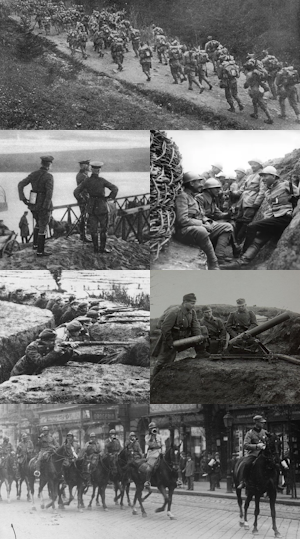 (clockwise)
| |||||||
| |||||||
| Main belligerents | |||||||
|
|
| ||||||
| Commanders and leaders | |||||||
|
|
| ||||||
| Strength | |||||||
|
|
| ||||||
| Casualties and losses | |||||||
|
287,000 killed 380,000 wounded |
296,000 killed 320,000 wounded | ||||||
The Marsh Wars (Castonish: Guerras de las Marismas; Ezervulgish: Mocsarak háborúi) were a series of conflicts in the early 20th century as a result of a decade of crumbling Stoino-Ezervulgish relations. Open hostilities began on 5 September 1914 and would be marked by both swithering and static frontlines until 13 November 1918. The war would be named after the formation of marshes due to extreme weather conditions elevated through trench warfare. The conflict was one of Pacifica's first wars with the widespread use of trenches, chemical weapons, tank warfare and modern infantry tactics.
Background
Both Stoinia and Ezervulge had become industrialised societies following the industrial revolution. Although a significant discrepancy was present due to Ezervulge losing a large portion of its industrial power after Peter I's War, the nation was slowly catching up again to western maritime powers such as Stoinia and Sedunn. It was in this spirit of catching up that the Ezervulgish King George II sought a policy of pan-Ezervulgism which brought it head-to-head with Stoinia which housed some 300,000 Ezervulgish in the Loreto, Corrientes and Norano provinces since the Hunyars' Sacking of Tolosa. King George II wished to establish a dominant Bailtemmic nation with all Ezervulgish people under one rule. These border provinces, in addition to hosting Ezervulgish minorities, were rich in coal and steel mines which would help fuel the further industrialisation of Ezervulge. Furthermore, in 1911 large deposits of gold were found in the Stoinian Corrientes province which could spearhead Ezervulge's global economic trade power. It was hoped that their incorporation would resurge Ezervulge as a Bailtemmic power since the defeat in Peter I's War as well as serve as a long-term economic investment to consolidate Ezervulgish prosperity, which in turn would again strengthen the position of the Ezervulgish King.
Stoinia was focusing on its overseas territories through industrial development programs. Especially Shai Kong's harbour expansion had become a priority against Paeonisian and Izaakian competition as Stoinia wished to maintain its role in global trade. Recently, Shai Kong had become overcrowded and the lack of infrastructure had made Hai Men Island a preferable choice over Shai Kong. This required government intervention overseas to fully develop Corinian industries so that they may operate autonomously. In addition, citizens overseas had grown their own identities which had caused incidents of rebellion. As such, Prime Minister Tiberiu Stolojan frequently voyaged to Corinia and Carraca to oversee the industrialisation of the overseas territories. This would however invite Ezervulgish opportunism.
Stoino-Ezervulgish relations would start to deteriorate from 1908 and Ezervulgish Ambassadors would become increasingly volatile and propagate stories of how Ezervulgish in Stoinia are abused by Stoinian governance. Later studies would show that Ezervulgish marginalisation happened due to significant language barriers in local administrations. Nonetheless, the Ezervulgish rhetoric only grew more zealous over the years until it reached a breaking point on 5 September 1914 when Ezervulge formally declared war with the intent to liberate the Ezervulgish minority in Stoinia.
Strategy
Stoinia

Line infantry had largely remained the main doctrine of the Stoinian Royal Army, which had been cemented by the Elbonian Wars. However, the military staff was in an era of rejuvenation in the latter half of the 19th century. Under the New College (Castonish: Nuevo Colegio), young officers brought a wind of change through pressure to modernise infantry tactics under the guidance of the rising General Jorge Aranda. Nonetheless, the Stoinian government from 1880 to 1910 had primarily focused on modernising the Stoinian Royal Navy which consequently brought forms of stagnation to the Royal Army. Stoinian military staff was known for tense relations between the naval & army branches as well as for internal tension within the Royal Army staff.
The Stoinian military-industrial complex would however continue to revolutionise military equipment such as machine guns, helmets and artillery cannons. The New College would be spread over the issues where to focus new Stoinian Royal Army doctrine by the means of new equipment. Military theorists formulated strategies utilising prototype aircraft as well as train-mounted artillery. During this period, not one doctrine was dominant as the military leadership was spread on the various strategies. Instead, the military staff encouraged officers to take the initiative and experiment in military exercises.
This was only strengthened through Stoinian officers partaking in joint military exercises with other nations such as Sedunn and rising naval powers like Karnetvor and Techganet. At the start of the 20th century, Stoino-Ezervulgish relations were still amicable and officers such as Major-General Ramiro De Sarro and General Mákkeszőr Ámbrus engaged in bilateral training exercises incorporating tactics to test out new military equipment. Ezervulgish prototypes had gained the interest of Stoinian military staff and Major-General Ramiro De Sarro was sent to evaluate the merits. However, political forces had pressured to prioritise naval investments over equipment modernisation.
The Stoinian military at the time largely comprised volunteers and was slowly becoming more and more professionalised. It primarily served as a way for aristocratic families to serve the Kingdom, but recent liberalisation policies opened up leadership positions to soldiers from the ranks. This brought a new wave in the military leadership who largely joined the New College's beliefs to modernise the institution. Even though social stigmas were present, the Stoinian Royal Army would continue to pursue a course towards liberalisation and innovation.
Ezervulge — Szilágyi-plan

Events
First Marsh War
Villámló Ló offensive
- Villámló Ló offensive
-
A portrait of Field Marshal Mákkeszőr Ámbrus in Hunyászok uniform in 1914.
-
Field Marshal Mákkeszőr Ámbrus at the Crossing of the Narcea, following the Battle of Carreño.
-
Field Marshal Mákkeszőr Ámbrus inspecting his troops in Carreño.
Stoinian counter-offensive & Flooding of the Ebro
- Flooding of the Ebro
-
Flooding in Loreto following the building of the dyke in Sariego.
-
Mudded Ezervulgish trench following the flooding of the Ebro.
-
Ezervulgish lines east of Noreña in 1915.
-
Stuck Ezervulgish artillery near the Cudillero front in 1915.
Second Marsh War
Second Ezervulgish invasion & stalemate
- Summer War
-
Stoinian troops in watered-down trenches.
-
Stoinian tank escorted by a platoon at the Battle of X.
-
Stoinian soldiers wearing newly issued gas masks for protection against gas attacks.
-
Ezervulgish tanks unloaded for the Battle of Y.
-
Stoinian III Army marching through Varcathian mountain passes to flank Ezervulgish lines.
Caballo Salvaje offensive
- Caballo Salvaje offensive
-
Stoinian trench offensive.
-
Stoinian tanks advancing Ezervulgish fields.
-
Stoinian cavalry in Sárkanyvölgy.
-
King Alexandru VIII inspecting troops in Sárkanyvölgy.
-
Stoinian troops feeding Ezervulgish citizens.

